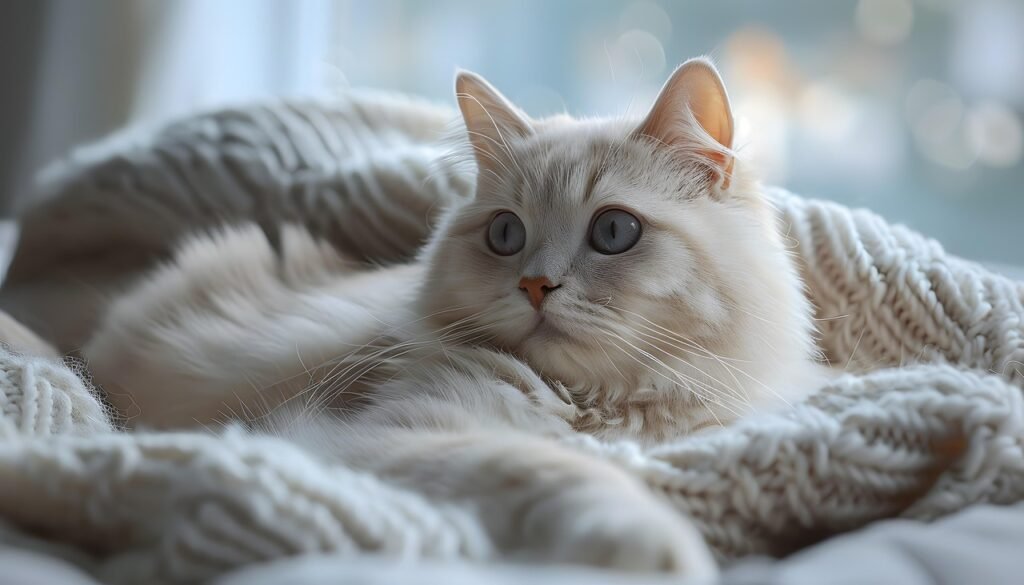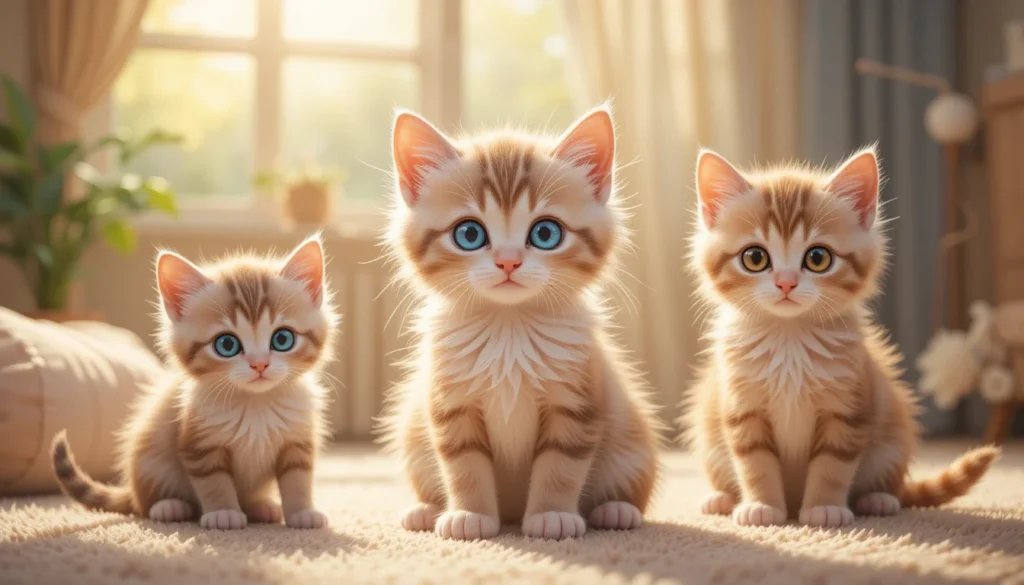When Do Kittens’ Eyes Change Color? A Guide for Cat Owners
When Do Kittens Eyes Change Color Bringing home a new kitten is exciting, especially with their striking baby-blue eyes. But did you know those eyes might not stay that color?
Just like human babies, all kittens are born with blue eyes, which often change color as they grow. This guide will explain why this happens, when to expect the change, and what factors influence their final eye color.
Why Are All Kittens Born with Blue Eyes?
All kittens are born with blue eyes because of the lack of pigment in their irises. The blue color you see is a result of light refracting off the iris, similar to how the sky appears blue. Over time, specialized cells called melanocytes begin to produce melanin, the pigment that determines the final eye color.
Kitten Eye Development Timeline
- Birth: Kittens are born with their eyes closed.
- 7–10 Days: Their eyelids begin to open, but their vision is still blurry.
- First Month: Kittens can only see blurred shadows and light.
- 7 Weeks: The color of their eyes typically begins to shift as melanin production starts.
- 12 Weeks: By this age, most kittens will have their final, permanent eye color.
- 16 Weeks: Full vision is developed.
The Role of Melanin in Eye Color – When Do Kittens Eyes Change Color
Melanin is the pigment responsible for the color of eyes, skin, and hair. As melanocytes in a kitten’s iris begin to produce melanin, the eye color changes from blue to its final shade.
- More Melanin: Results in darker eye colors, such as brown or copper.
- Less Melanin: Leads to lighter eye colors, like green or hazel.
How to Predict Your Kitten’s Adult Eye Color
Predicting a kitten’s final eye color can be tricky, but there are some clues you can look for When Do Kittens Eyes Change Color.
- Genetics: A kitten’s eye color is inherited from its parents. If both parents have blue eyes, their kittens are more likely to keep that color.
- Breed: Certain breeds are known for specific eye colors. For example, Siamese cats typically have striking blue eyes, while Russian Blue cats often have bright green eyes.
- Early Signs: If your kitten’s eyes are still a solid blue after eight weeks, there’s a strong chance they will remain blue. Early signs of a change, like flecks of green or gold, usually indicate that the final color will be a variation of those shades.
Some people believe that a cat’s eye color is linked to its personality, but there is no scientific evidence to support this. However, eye color can be an indicator of health.
Health Concerns: Pay attention to any unusual changes in your kitten’s eye color.
Cloudiness or a sudden shift in pigmentation can be a sign of an eye infection, injury, or underlying disease. Always consult a veterinarian if you notice anything unusual.
Common Questions About Kitten Development
When Can I Start Holding Kittens?
Kittens are very fragile. It’s best to avoid holding them before they are two weeks old. At two weeks, gentle handling is safe and can help with their socialization.
When Do Kittens Open Their Eyes?
Kittens are born with their eyes closed and sealed. They begin to open between 7 and 10 days old, and both eyes should be fully open by two weeks of age When Do Kittens Eyes Change Color.
What is the Rarest Cat Eye Color?
Although all kittens are born with blue eyes, true blue eyes in adult cats are quite rare. They are most common in white cats or breeds like the Siamese. When Do Kittens Eyes Change Color Other uncommon eye colors include orange and copper. The most common eye colors for cats are green and yellow.
When and Why Do Kittens’ Eyes Change Color?
Watching a kitten’s eyes transform from a baby blue to their final, adult color is a fascinating part of their growth When Do Kittens Eyes Change Color. This change is all due to a pigment called melanin, which is responsible for the color of eyes, skin, and hair.

The Science Behind the Color Change
- At Birth: Kittens have no pigment in their irises. The blue color is a result of light scattering, similar to how the sky appears blue When Do Kittens Eyes Change Color.
- Over Time: Specialized pigment cells called melanocytes begin to produce melanin. The amount of melanin produced determines the final eye color.
- Final Color: More melanin results in a darker color like brown or copper, while less melanin leads to lighter shades like green or amber.
When Does the Change Happen?
The color change typically starts around 4 to 8 weeks of age. By the time a kitten is 12 weeks old, its eyes will most likely have settled into their permanent adult color When Do Kittens Eyes Change Color.
What to Know About Kitten Litters and Father Cats
Litter Size
- Litter sizes can range from 1 to 9 kittens, with the average being 3 to 5.
- First-time mothers often have smaller litters.
Do Father Cats Recognize Their Kittens?
Unlike mother cats, male cats (tomcats) generally lack paternal instincts. Once they have sired a litter, they typically leave and show no interest in raising their kittens When Do Kittens Eyes Change Color.
Predicting Your Kitten’s Eye Color
It’s nearly impossible to know for certain what a kitten’s eye color will be without knowing its breed and parentage.
Breeds and Eye Color
- Amber and Copper Eyes: Amber is a common eye color, but a dark copper shade is rare and often linked to breeds like the Chartreux and Bombay.
- Odd-Colored Eyes (Heterochromia): Some breeds, like the Khao Manee and Turkish Van, are genetically predisposed to having one blue eye and one of another color When Do Kittens Eyes Change Color.
- Blue Eyes: While all kittens start with blue eyes, only certain breeds like the Siamese and Ragdoll retain this color into adulthood.
When to See a Vet
Sometimes, eye color can be an indicator of health issues. If a kitten’s eyes have a coppery shade along with symptoms like lethargy, seizures, or low body weight, it could signal a health problem like a liver disease. Always consult a veterinarian if you notice any unusual eye changes or other health concerns.
Understanding the Spectrum of Cat Eye Colors
Adult cats can have a stunning range of eye colors.
- Green: From light sage to deep emerald.
- Yellow/Gold: The most common colors, ranging from pale yellow to a deep amber.
- Blue: Retained by specific breeds.
- Copper and Orange: These rare, reddish-brown tones are highly sought after.
- Odd-Eyed (Heterochromia): One eye is a different color from the other, often a combination of blue with green, gold, or amber.
The fascinating process of a kitten’s eye color change is a natural part of their development, determined by their genetics and the production of melanin When Do Kittens Eyes Change Color.
Do Cats’ Eyes Change Color Later in Life?
Many people wonder if a cat’s eye color can change after kittenhood.1 While kittens’ eyes famously transform from a baby blue to their permanent adult color, subtle shifts can occur later in life due to aging or health factors.2 Understanding these changes can help you know what’s normal and when to be concerned.
The Natural Process of Eye Color Change
As a cat ages, it’s normal for its eye color to undergo subtle, gradual changes. These may include a slight fading or a deepening of the original shade. This is part of the natural aging process and is not a cause for concern.
Health and Medical Factors
Sometimes, a change in eye color can be linked to an underlying medical condition.3 You should monitor for these issues, as they may require veterinary care:
- Uveitis: Inflammation of the eye can alter its appearance and color.4
- Cataracts: A cloudy appearance that can hide the eye’s true color.5
- Glaucoma: Changes in eye pressure can affect both vision and color.6
- Iris Melanosis: Dark, pigmented spots can appear on the iris, which is usually harmless but should be monitored by a vet.
Also Read To This : Can Eye Drops Expire

Understanding Kitten Eye Development
All kittens are born with their eyes sealed shut. They begin to open between 7 and 14 days, revealing a cloudy, bluish iris. The eyes’ color change is a gradual process.
Kitten Eye Color Timeline
- 3–8 Weeks: The first hints of melanin begin to appear, causing the blue iris to darken.7
- 2–3 Months: You will see a noticeable shift as the eyes settle into their new shade.8
- 3–4 Months: By this time, the kitten’s permanent adult eye color is typically set.9
Genetics and Breed Influence on Eye Color
A cat’s genetics and breed play a significant role in determining its final eye color.10
- Siamese: This breed is known for always having blue eyes.11
- Russian Blue: These cats typically have a striking emerald green shade.
- Persians: Many Persians have copper or golden eyes.
- White Cats: Some white cats have odd-colored eyes (heterochromia), with one eye being blue and the other a different color.12
When to Be Concerned About a Cat’s Eye Color Change
While some changes are normal, others can be a sign of a health problem.13
Normal Changes: When Do Kittens Eyes Change Color
- A gradual color change in a kitten under four months of age.14
- A subtle fading or deepening of an adult cat’s eye color over many years.
Abnormal Changes That Require a Vet Visit:
- A sudden color change in an adult cat.15
- One eye changing color while the other remains the same.
- Signs of illness, such as lethargy, pain, or vision issues.
- Cloudiness or discharge from the eye.
Any significant or rapid change in an adult cat’s eye color can be a red flag for underlying disease or trauma.16 If you notice a shift, it’s always best to consult your veterinarian to rule out conditions like uveitis or glaucoma.17
Environmental Factors and Eye Color – When Do Kittens Eyes Change Color
The way you perceive your cat’s eye color can also be influenced by a few external factors When Do Kittens Eyes Change Color:
- Lighting: A cat’s eyes may look different under natural light versus artificial light.18
- Pupil Dilation: When a cat’s pupils are wide, you can see less of the iris, making the eye color appear different.19
- Surrounding Colors: The color of your cat’s fur or its background can affect how its eye color is perceived.
